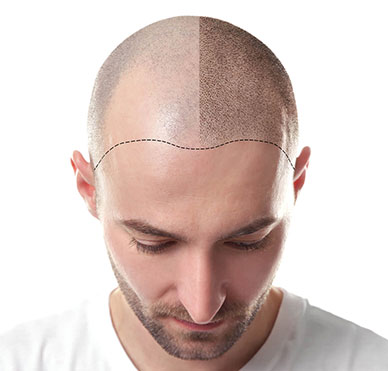HAIR TRANSPLANTATION
Hair transplantation is a method that is mostly seen in men after hair loss due to hormonal disorders, wrong drug use, genetic factors.

Introduction
Welcome to Egemed Hospital, a trusted provider of transformative plastic surgery services. In this article, we will explore hair transplant, a surgical procedure aimed at restoring hair growth in areas experiencing hair loss or thinning. We will cover how hair transplant works, the conditions it treats, candidate eligibility, types of hair transplant surgery, grafting techniques, and more.
What is Hair Transplant?
Hair transplant is a surgical procedure that involves harvesting hair follicles from areas of the scalp where hair growth is abundant (donor site) and transplanting them to areas with thinning or balding (recipient site). The goal of the procedure is to restore natural hair growth, providing patients with a fuller and more youthful appearance.
How does a Hair Transplant Work?
Hair transplant works by relocating healthy hair follicles to areas experiencing hair loss. During the procedure, a skilled surgeon extracts hair follicles from the donor site, usually the back or sides of the scalp, using either the FUT (Follicular Unit Transplantation) or FUE (Follicular Unit Extraction) method. The harvested follicles are then carefully transplanted into tiny incisions in the recipient site, where they will grow and thrive.
Conditions Treated by Hair Restoration Surgery
Hair restoration surgery is an effective treatment for various conditions related to hair loss, such as male pattern baldness, female pattern hair loss, alopecia areata (patchy hair loss), and hair loss due to injury or scarring.
Who is a Candidate for Hair Replacement?
Candidates for hair replacement are individuals with noticeable hair loss or thinning who have sufficient healthy hair follicles at the donor site. Ideal candidates should be in good overall health, have realistic expectations about the outcomes, and be committed to post-operative care.
Different Types of Hair Transplant Surgery
There are two main types of hair transplant surgery:
1. Follicular Unit Transplantation (FUT): Involves removing a strip of scalp from the donor site, and then dissecting it into individual hair follicles for transplantation.
2. Follicular Unit Extraction (FUE): Involves harvesting individual hair follicles directly from the donor site, leaving tiny puncture scars that heal without visible linear scarring.
Grafting Techniques in Hair Transplant
In hair transplant surgery, grafting refers to the transplantation of individual hair follicles or groups of hair follicles (grafts). The surgeon meticulously places these grafts in the recipient site to achieve a natural and aesthetically pleasing hairline.
Scalp Reduction, Flap Surgery, and Tissue Expansion
Scalp reduction, flap surgery, and tissue expansion are advanced hair restoration techniques that may be recommended for specific cases. Scalp reduction involves surgically removing bald areas of the scalp and pulling the remaining hair-bearing scalp closer together. Flap surgery uses a portion of the scalp with healthy hair and moves it to cover the balding area. Tissue expansion involves inserting a balloon-like device under the scalp to stretch the skin and create extra skin for hair transplantation.
Risks and Side Effects of Hair Transplant Surgery
As with any surgical procedure, hair transplant surgery carries certain risks, including infection, bleeding, scarring, and an unnatural appearance if not performed by a skilled surgeon. Some common side effects may include swelling, redness, and minor discomfort at the donor and recipient sites, which are usually temporary and resolve on their own.
Benefits of Hair Restoration
Hair restoration surgery can have a profound impact on a person’s self-confidence and quality of life. Patients often experience a renewed sense of self-esteem and an improved overall appearance after the procedure.
Recovery Process After Hair Transplant Surgery
After hair transplant surgery, patients can expect some minor discomfort and swelling in the treated areas. Most individuals can return to work and normal activities within a few days, but it is essential to follow the surgeon’s post-operative instructions carefully for optimal results.
Longevity of Hair Transplant Results
Hair transplant results are considered permanent because the transplanted hair follicles are resistant to the effects of the hormone dihydrotestosterone (DHT), which is responsible for hair loss in pattern baldness. However, natural aging and genetic factors can still impact the appearance of the surrounding hair over time.
When to See Your Healthcare Provider about a Hair Transplant
If you are experiencing noticeable hair loss or thinning and are considering hair restoration, it is advisable to schedule a consultation with a qualified and experienced hair transplant surgeon. They will evaluate your hair loss pattern, discuss suitable treatment options, and address any concerns you may have.
Conclusion
Egemed Hospital is dedicated to providing expert hair transplant services, restoring your natural hairline and confidence. If you are seeking a reliable solution for hair loss, we invite you to schedule a consultation with our skilled team to discuss your options and embark on a journey to regain your full head of hair and self-assurance.

How is the Operation Performed?
- Local Anesthesia
- After 4-8 hours of procedure, can be discharged in the same day
ACCOMMODATION
The opportunity of reliable and comfortable accommodation in our contracted 5 star hotels are waiting for you.
TRANSFER SERVICE
We meet out domestic or foreign patients with our transfer them safely.
TRAVEL PLAN
Before your travel, we make the required arrangements and plan the travel together with you.
PRIVATE ASSISTANT
Our private interpreters will accompany you in line with your demands, for ensuring you to feel comfortable throughout the treatment period.
TOURISTIC TRIPS
Enjoyable tours are organized for you to see the pleasant and historical places of the city during the treatment period.

